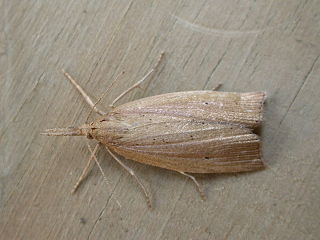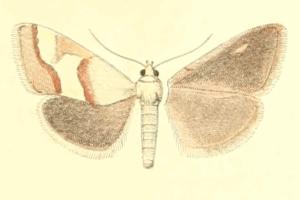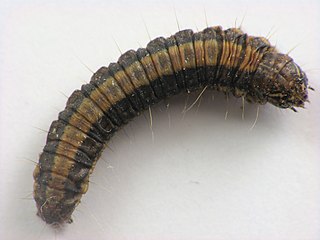
The Crambidae are the grass moth family of lepidopterans. They are variable in appearance, the nominal subfamily Crambinae taking up closely folded postures on grass stems where they are inconspicuous, while other subfamilies include brightly coloured and patterned insects which rest in wing-spread attitudes.

The Pyralidae, commonly called pyralid moths, snout moths or grass moths, are a family of Lepidoptera in the ditrysian superfamily Pyraloidea. In many classifications, the grass moths (Crambidae) are included in the Pyralidae as a subfamily, making the combined group one of the largest families in the Lepidoptera. The latest review by Eugene G. Munroe and Maria Alma Solis retain the Crambidae as a full family of Pyraloidea.

The Pyraloidea are a moth superfamily containing about 16,000 described species worldwide, and probably at least as many more remain to be described. They are generally fairly small moths, and as such, they have been traditionally associated with the paraphyletic Microlepidoptera.

Spilomelinae is a very species-rich subfamily of the lepidopteran family Crambidae, the crambid snout moths. With 4,132 described species in 340 genera worldwide, it is the most speciose group among pyraloids.
In biological taxonomy, circumscription is the content of a taxon, that is, the delimitation of which subordinate taxa are parts of that taxon. If we determine that species X, Y, and Z belong in Genus A, and species T, U, V, and W belong in Genus B, those are our circumscriptions of those two genera. Another systematist might determine that T, U, V, W, X, Y, and Z all belong in genus A. Agreement on circumscriptions is not governed by the Codes of Zoological or Botanical Nomenclature, and must be reached by scientific consensus.
Asciodes is a genus of snout moths in the subfamily Spilomelinae of the family Crambidae. The genus was erected by Achille Guenée in 1854 with Asciodes gordialis as type species.

Calamotropha is a genus of moths of the family Crambidae.

Chilo is a genus of moths of the family Crambidae. Some of these moths are called borers.

Evergestis is a genus of moths of the family Crambidae described by Jacob Hübner in 1825. A number of species are pests, including the cross-striped cabbageworm, a pest of cole crops such as cabbage.

Udea is a genus of snout moths in the subfamily Spilomelinae of the family Crambidae. The genus was erected by Achille Guenée in 1845. The currently known 214 species are present on all continents except Antarctica. About 41 species are native to Hawaii.

Neurophyseta is a genus of moths of the family Crambidae.
Nomis is a genus of moths of the family Crambidae.

Placosaris is a genus of snout moths in the subfamily Pyraustinae of the family Crambidae. It is placed in the tribe Pyraustini.

Tegostoma is a genus of moths of the family Crambidae.

Titanio is a genus of moths of the family Crambidae.

The Phycitinae are a subfamily of snout moths. Even though the Pyralidae subfamilies are all quite diverse, Phycitinae stand out even by standards of their family: with over 600 genera considered valid and more than 4000 species placed here at present, they unite up more than three-quarters of living snout moth diversity. Together with the closely related Epipaschiinae, they are apparently the most advanced lineage of snout moths.

The Epipaschiinae are a subfamily of snout moths. Almost 600 species are known today, which are found mainly in the tropics and subtropics. Some occur in temperate regions, but the subfamily is apparently completely absent from Europe, at least as native species. A few Epipaschiinae are crop pests that may occasionally become economically significant.

Glaphyriinae is a subfamily of the lepidopteran family Crambidae. It was described by William Trowbridge Merrifield Forbes in 1923. The subfamily currently comprises 509 species in 75 genera.

Scopariinae is a subfamily of the lepidopteran family Crambidae. The subfamily was described by Achille Guenée in 1854.
Nomis baibarensis is a moth in the family Crambidae. It was described by Shibuya in 1928. It is found in Taiwan.












